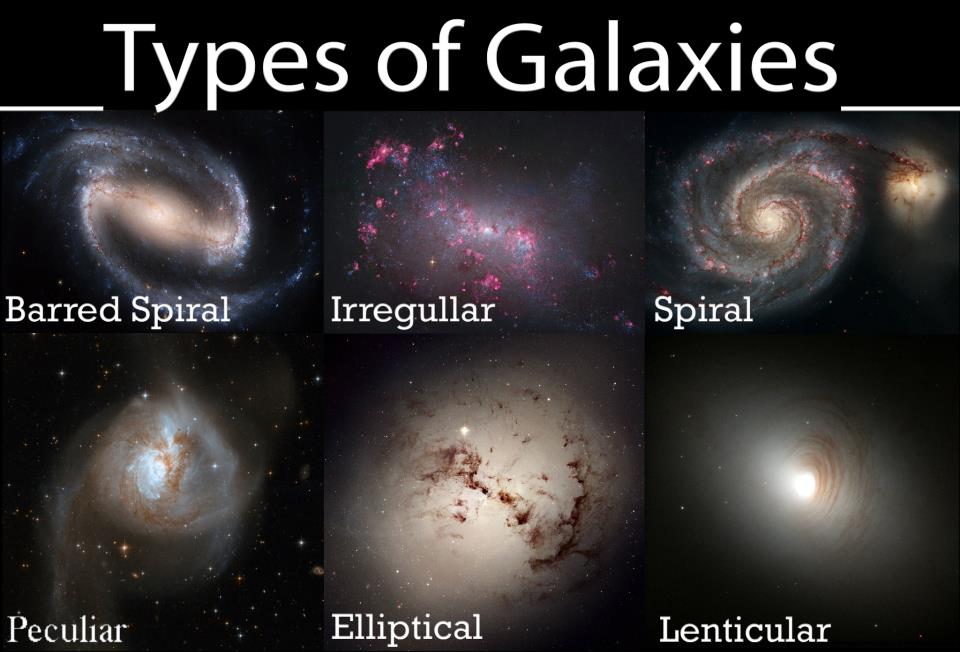

Surprisingly, over the course of most of humanity’s existence, we had no idea that other galaxies even existed. All we could see was our own little corner of the universe. It wasn’t until the early 1900’s that the nature of the so-called “Andromeda nebula” was discerned. Edwin Hubble settled the galaxy vs. nebula debate in 1925, and it was finally revealed that this “nebula” was actually a galaxy containing some 400 billion stars and not simply an extension of our own galaxy. Almost 100 years later, our reality (and relative insignificance) is well known, as we are now aware of the fact that the universe contains several BILLION large galaxies, many of which are similar to our own (current estimates guess that there are 100 to 200 billion galaxies in the Universe). With that revelation, we’ve learned that galaxies come in all shapes and sizes too. “So what other kinds of galaxies are there,” you might ask? Here are the main types:
Elliptical Galaxies:
First and foremost, we have elliptical galaxies: the largest (and arguably most dull) of the bunch. Generally, galaxies of this type are older and have no overly defined structure (they usually resemble an American football, and are about 6 million light-years across). In addition to this, they don’t contain many star forming regions, as they have used the bulk of their stellar material early in their formation. The massive size of galaxies of this type can be attributed to several galactic mergers, an event prone to advancing star formation activity. During these mergers, many massive stars are formed, which typically live fast and die hard, ejecting mass quantities of heavy metals into the interstellar medium.
Spiral Galaxies:
Next, we have spiral galaxies. Our galaxy, and our closest neighbor (Andromeda), are among this type. Galaxies of this type tend to be structured similar to a pinwheel, with a large central bulge, expansive disks, and a halo. They have bright central regions, where intricate filaments of stellar materials extend from. Some of their arms can extend several hundreds of thousands of light-years across (the Milky Way is about 100,000 light-years across, all in all), and they have stars of various ages scattered about. The material is organized in a way that is conductive to star formation, as something called “density waves” cause the material to circulate through the spiral arms like circling waves, where they ultimately squeeze and collapse, giving life to new stars.
Oddly enough, this classification has two flavors. There are ordinary spiral galaxies and barred spiral galaxies. The Milky Way was long thought to merely be a spiral galaxy, but recently, we found that the Milky Way is actually a barred spiral galaxy. This means that in our central region, we have a large bar near the nucleus where the spiral arms (one contains our solar system) branch out from. Barred-galaxy types usually have spiral arms that are tightly wound. Whilst the ordinary spiral galaxies are looser and less defined.
Lenticular Galaxies:
A lenticular galaxy is the love child of spiral and elliptical galaxy, usually containing a central bulge with no spiral arms (sometimes, they are even referred to as “armless spiral galaxies” (take from that what you will). Many astronomers believe they are the evolutionary bridge between a spiral and elliptical galaxy. They can often be misidentified as either/or, depending on our frame of reference (if we are seeing the galaxy edge or face-on)
Irregular Galaxies:
All galaxies are separated by large expanses of empty interstellar space, but most are anchored together by immense gravitational force. Because of this, galaxies that are millions of light-years apart can be drawn toward one another, eventually coming within several thousands of light-years of one another. Some of these galaxies merely interact, before one darts off. Whilst others actually merge, forming newer (more spectacular) galaxies. The result of such a collision is almost always beautiful, but they still leave lasting scars.
As such, many galaxies that have interacted or merged do not have predictable structures. They come in many flavors. Some resemble birds or cigars (like M82, or the Cigar Galaxy), while others look like giant blobs of glowing dust (like the one seen here). Following this similar classification, irregular galaxies often look very similar to peculiar galaxies. Only some of them can develop unusual features (such as jets emanating from the central region in two opposite directions).
Dwarf Galaxies:
Lastly, we come to the smallest rung on the latter: dwarf galaxies. There might be TRILLIONS of them in the universe, most in orbit around other galaxies. The Milky Way may have as many as 26 of them bound to it (The Large and Small Magellanic Clouds were once thought to be, but recent observations indicate that the small galaxies are traveling to fast to be anchored to us.)